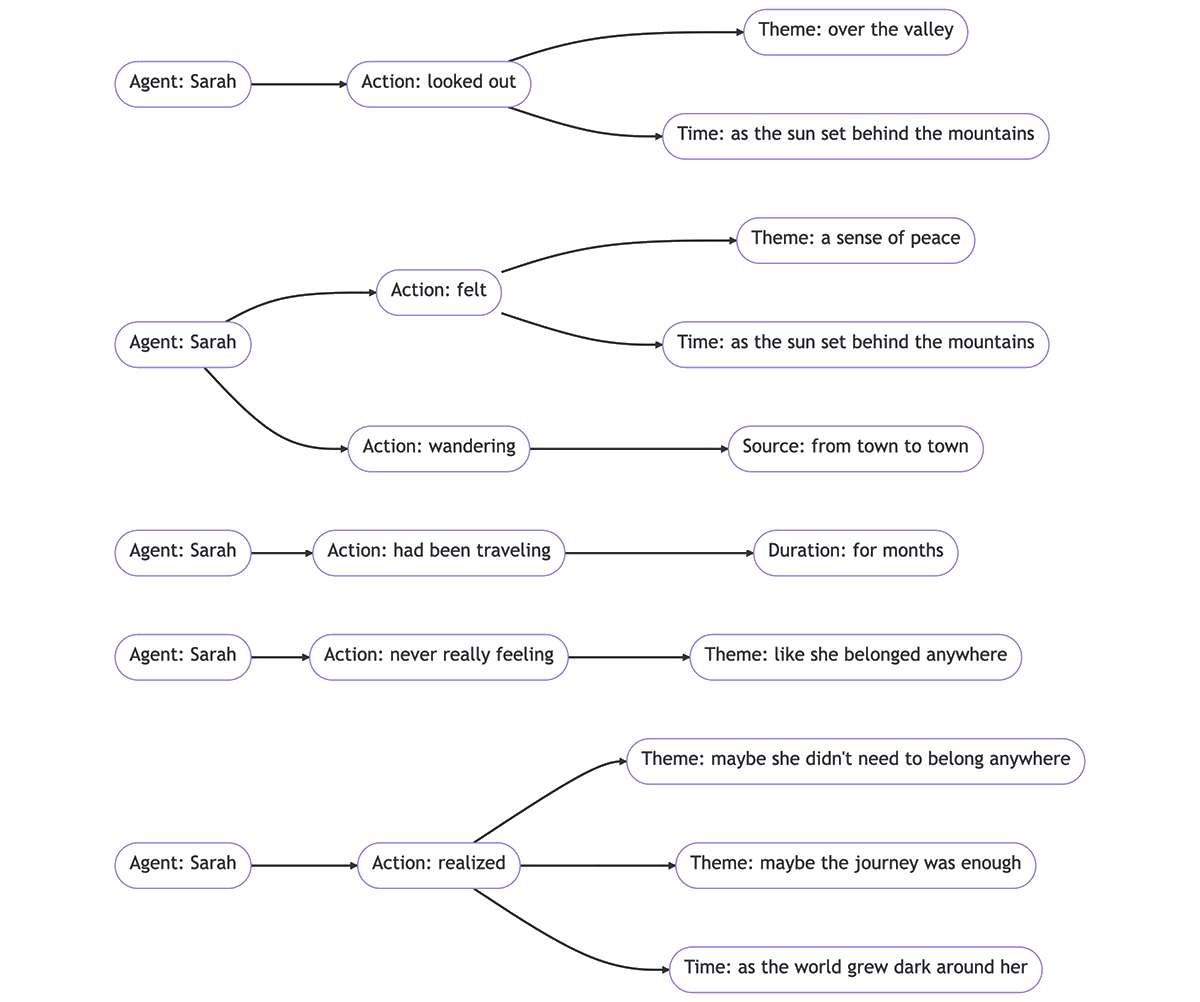Unveiling the Potential of Semantic Role Labeling with LLMs
- 8 minutes read - 1577 words
Table of Contents
Semantic Role Labeling (SRL) is crucial in natural language processing (NLP). It aims to identify a sentence’s semantic roles or arguments and associate them with the appropriate predicate, typically a verb. By understanding the relationships between words and phrases, SRL helps to comprehend the meaning and structure of a sentence. It has various applications, such as question answering, information extraction, text summarization, and machine translation.
In this blog post, we will explore the world of Semantic Role Labeling, how it differs from aspect-based sentiment analysis, the core NLP tasks involved, and its applications using ChatGPT. We will also discuss the limitations of using ChatGPT for SRL and how to address them.
Difference between semantic role labeling and aspect-based sentiment analysis
Semantic Role Labeling (SRL) and Aspect-Based Sentiment Analysis (ABSA) are essential NLP tasks, but their purposes and applications are distinct.
SRL determines “who did what to whom” in a sentence, analyzing the relationships between words and phrases. This process involves identifying semantic roles like agents, patients, and instruments. As a result, SRL is crucial for various NLP applications such as question answering, information extraction, and text summarization.
On the other hand, ABSA goes beyond traditional sentiment analysis by identifying specific aspects or attributes of a subject (e.g., product, service, or topic) and analyzing the sentiment associated with each aspect. This method allows a more nuanced understanding of people’s opinions and feelings. ABSA is typically used for analyzing product reviews, social media monitoring, customer support, market research, and public opinion analysis.
In summary, SRL focuses on understanding semantic relationships within a sentence, while ABSA aims to extract sentiments linked to specific subject aspects. Each task contributes to enabling machines to understand better and process natural language.
Semantic Role Labeling and FrameNet
Semantic Role Labeling (SRL) and FrameNet are two different approaches to capturing semantic information in natural language understanding. Here’s an overview of the key differences between the two:
Semantic Role Labeling (SRL)
SRL is a computational linguistic task that aims to identify and classify the roles played by various constituents in a sentence concerning a specific predicate or verb. It focuses on assigning semantic roles such as agent, patient, theme, and location to the syntactic constituents of a sentence.
Representation: SRL typically represents the semantic roles as labeled dependencies or annotations associated with specific syntactic constituents in a sentence.
Focus: SRL is primarily concerned with the roles played by participants or entities about a particular predicate. It identifies and classifies these roles based on the verb’s semantic requirements.
Application: SRL has been widely used in various NLP tasks such as information extraction, question answering, and machine translation. It provides valuable information about the thematic structure and relationships within a sentence.
FrameNet
FrameNet is a lexical-semantic resource that organizes words and phrases based on the frames they evoke. Frames represent conceptual structures that capture the underlying meaning or scenario associated with a particular word or phrase. Each frame consists of frame elements, which correspond to specific semantic roles.
Representation: FrameNet represents semantic information regarding frames, frame elements, and their relationships. It provides a structured representation of the meaning and usage of words in different contexts.
Focus: FrameNet identifies and classifies frames associated with lexical units (words or phrases). It aims to capture rich semantic knowledge, including event structures and the roles played by participants within those frames.
Application: FrameNet is used for various NLP tasks, including semantic parsing, text understanding, and information extraction. It enables deeper language analysis by providing detailed information about the meaning and usage of lexical units in specific contexts.
Relationship between SRL and FrameNet
Semantic Role Labeling and FrameNet aim to capture semantic information in natural language. While SRL focuses on identifying and labeling specific semantic roles associated with verbs in a sentence, FrameNet provides a broader framework that captures the semantic meaning and conceptual structure of words and phrases across various frames.
By leveraging its rich lexical-semantic knowledge and frame-based representations, SRL can benefit from FrameNet. On the other hand, FrameNet can utilize SRL techniques to provide more detailed and fine-grained information about the semantic roles associated with frame elements.
In summary, Semantic Role Labeling and FrameNet offer complementary approaches to capturing semantic information. SRL focuses on verb-specific roles, while FrameNet provides a broader framework for representing and organizing lexical-semantic knowledge across various frames.
NLP Tasks Used for Semantic Role Labeling
Several core NLP tasks are necessary for Semantic Role Labeling:
Part-of-speech (POS) tagging Identifying the grammatical category of each word (noun, verb, adjective, etc.) is essential for understanding the structure of a sentence and determining possible semantic roles.
Dependency parsing This task generates a dependency graph that depicts the relationships between words in the sentence. It helps to determine which words are related and how they are connected.
Named Entity Recognition (NER) Identifying named entities (such as people, organizations, locations, and dates) within the text contributes to semantic role labeling. Named entities often act as arguments or semantic roles in a sentence.
Predicate-argument structure identification This involves recognizing predicates (typically verbs) and their corresponding arguments and associating them with the correct semantic role.
These NLP tasks can be leveraged to create knowledge graphs with semantic role labeling, as they provide a structured representation of the information found in sentences. Knowledge graphs can be used in applications like knowledge base question answering, information retrieval, and recommendation systems.
Applications of Role-Playing with ChatGPT
Several potential use cases can benefit from ChatGPT-based Semantic Role Labeling:
Information extraction ChatGPT can extract relevant information and generate structured data for further processing and analysis by identifying the semantic structure of sentences.
Text summarization ChatGPT can leverage SRL to create concise and coherent summaries by understanding the crucial relationships within the text.
Question answering With a deeper understanding of the semantic roles, ChatGPT can improve its ability to answer questions related to subjects, objects, and actions in a given text.
Customer service chatbots Identifying specific user concerns becomes more accurate with SRL, enabling ChatGPT-powered chatbots to provide more tailored and effective responses.
Education and tutoring ChatGPT-based tutors can use semantic role labeling to comprehend student questions better and provide more personalized feedback.
Limitations of Semantic Role Labeling with ChatGPT and How to Solve Them
Despite its potential, there are limitations to using ChatGPT for Semantic Role Labeling:
Dependency on high-quality training data ChatGPT relies on extensive, well-labeled training data to recognize and assign semantic roles. To improve SRL performance, collect and maintain high-quality and diverse datasets.
Handling ambiguous sentences Ambiguity can lead to incorrect semantic role assignment. Enhancing the model with additional contextual information or utilizing external knowledge might mitigate this issue.
The complexity of language Different languages may have varying syntactic and semantic structures, which may impact the performance of SRL systems. Developing language-specific models or multilingual models might be necessary for overcoming such challenges.
New or rare linguistic constructions ChatGPT may struggle to recognize and label new or rare linguistic constructions due to a lack of training data. Continuously updating the model with new examples can mitigate this problem.
Prompt Examples
Example 1 - Story
Prompt:
Semantic Role Labeling for: As the sun set behind the mountains, Sarah looked out over the valley and felt a sense of peace. She had been traveling for months, wandering from town to town, never feeling like she belonged anywhere. But at that moment, as the world grew dark around her, she realized that maybe she didn’t need to belong anywhere - maybe the journey was enough.
Result (part, for GPT-4):
As the sun set behind the mountains, Sarah looked out over the valley and felt a sense of peace wash over her.
Arg0 (Agent): the sun
ArgM-TMP (Temporal): As
Predicate: set
Arg1 (Theme): behind the mountains
Arg2 (Beneficiary): Sarah
Arg3 (Predicate): looked out
Arg4 (Theme): over the valley
Arg5 (Predicate): felt
Arg6 (Theme): a sense of peace
Arg7 (Manner): wash over her
Example 2 - Story as Graph
Prompt:
Semantic Role Labeling for: “As the sun set behind the mountains, Sarah looked out over the valley and felt a sense of peace wash over her. She had been traveling for months, wandering from town to town, never feeling like she belonged anywhere. But in that moment, as the world grew dark around her, she realized that maybe she didn’t need to belong anywhere - maybe the journey was enough.”; as mermaid code.
Result (part, for GPT-4):

Conclusion
Semantic Role Labeling with ChatGPT holds great potential for advancing various NLP applications. By identifying the relationships between words and phrases, SRL helps understand sentence meanings and structures.
While there are limitations, solutions like expanding training data, incorporating additional context, and using language-specific models can help address them.
Semantic Role Labeling can be combined with FrameNet to improve accuracy.
As we acknowledge both the possibilities and challenges, exploring and experimenting responsibly with ChatGPT-based Semantic Role Labeling is crucial. Doing so will allow us to tap into more advanced and nuanced natural language understanding applications.


